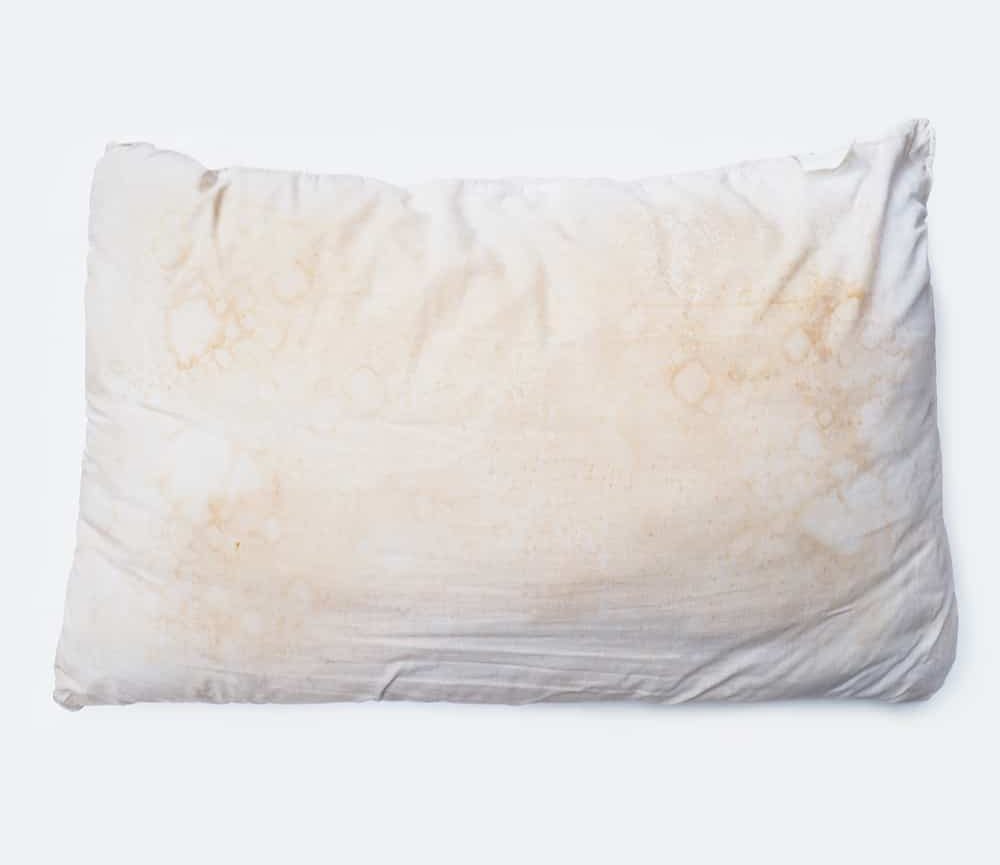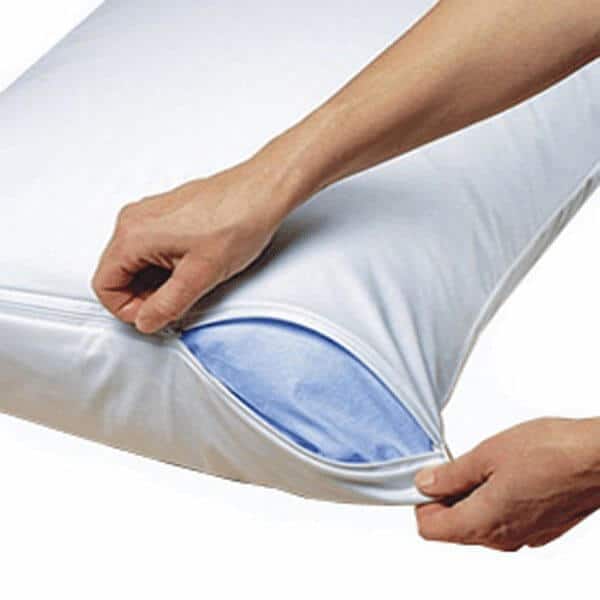
In the article
Last Updated on 05/06/2025 by Tony Abrahams
Waking up to stained, yellowed pillows is one of those sneaky, gross little problems that nobody ever warns you about… until it happens to you. Suddenly, your once-pristine pillow looks like it survived a flood, a BBQ, and a marathon sweat session all in one night.
If you’ve been frantically searching “stop my pillows from staining,” don’t worry — you’re not alone, and you’re definitely not helpless.
This guide is here to explain exactly why pillow stains happen, how to stop them for good, and how you can rescue the pillows you already own.
Spoiler: you can fix this without chucking everything in the bin and starting over.
Why Do Pillows Get Stained in the First Place?
Let’s get real: pillows don’t just stain out of nowhere. There’s a whole invisible party happening every night while you sleep — and not the good kind.
Here’s what’s crashing your pillow:
- Sweat: Even if you don’t feel sweaty, your body naturally releases moisture throughout the night. It’s completely normal — but over time, that moisture, combined with salts and body oils, seeps into your pillow.
- Drool: Whether you admit it or not, almost everyone drools at some point during deep sleep. That saliva soaks straight through your pillowcase and leaves stubborn marks.
- Hair oils and products: That silky conditioner you love? The gel that keeps your curls perfect? They all transfer onto your pillow. Oils and chemicals break down fabric fibres, leading to yellowing and weird textures.
- Skincare products: Night creams, face serums, acne treatments — they’re great for your skin but brutal on your bedding.
- Dead skin cells: Your body is constantly shedding tiny skin flakes. They sound harmless, but when mixed with moisture, they create a perfect recipe for stains, odours, and even dust mites.
Bottom line: Stains are basically a build-up of your body’s natural output. Totally normal — but totally preventable once you know how.

Stop My Pillows from Staining
How Can I Protect My Pillow from Stains?
Now that we know what’s happening, let’s talk battle plans. Protecting your pillows is way easier (and cheaper) than trying to rescue them after they’re already ruined.
Here’s how you create an iron wall of defence:
- Use a pillow protector:
Think of it as armour for your pillow. A good pillow cover protector adds an extra, invisible layer between your pillow and everything your body throws at it. Look for ones that are waterproof yet breathable, so you’re not sweating buckets during the night. - Double up your pillowcases:
One pillowcase is good. Two? Even better. That extra layer buys you more time between washes and stops oils and sweat from reaching the pillow itself. - Choose moisture-wicking fabrics:
Materials like bamboo or Tencel naturally repel moisture, which makes them absolute legends when it comes to resisting stains. - Dry your hair before bed:
Wet hair isn’t just a mildew magnet — it can break down fabrics too. Sleeping with bone-dry hair seriously helps keep your pillows fresher, longer. - Wash your face before sleeping:
Even if you don’t wear makeup, washing your face at night removes oils, skincare residue, and pollution particles that could otherwise end up ground into your pillow.
If you want the honest truth?
Setting up a pillow protector and washing your bedding a bit more often is way easier than buying new pillows every six months because they look like crime scenes.
Best Pillow Protectors for Stain Prevention
Not every “pillow protector” on the shelf deserves your money.
Here’s what you actually want to look for when picking one:
- Waterproof but breathable:
The best protectors have a thin, waterproof membrane that keeps out moisture while still letting air flow through. You don’t want to feel like you’re sleeping on a sweaty balloon. - Hypoallergenic materials:
If you have allergies, this is non-negotiable. A hypoallergenic protector blocks dust mites, mould, and pollen too — bonus! - Soft, quiet fabric:
Old-school vinyl or plastic covers make that awful crinkling sound every time you move. Modern ones use jersey knit, bamboo blends, or Tencel to stay whisper-quiet and comfy. - Easy to clean:
Always check if it’s machine washable and dryer-safe. You’re going to want to wash your protector about once a month to keep everything fresh.
Some hero materials to look for:
- Bamboo pillow protectors: Moisture-wicking, eco-friendly, and soft as anything.
- Tencel-based covers: Naturally resistant to stains and bacteria.
- Polyester jersey protectors: Good budget-friendly waterproof options without sacrificing comfort.
Hot tip:
Don’t cheap out. A great protector can make a $30 pillow last like a $300 one.

Stain proof pillow covers
How Often Should I Wash Pillowcases (and Pillows)?
Here’s where most people unknowingly sabotage their pillows: they don’t wash their bedding enough.
- Pillowcases:
Wash them at least once a week. If you sweat a lot or have oily hair/skin, twice a week is even better. - Pillow protectors:
Wash every 2 to 4 weeks. They’re tougher and can handle a little more grime before needing a clean. - Actual pillows:
Wash every 3 to 6 months. Yes, your pillows themselves need a bath.
Use a gentle cycle with mild detergent, and make sure to dry thoroughly to prevent mould or mildew.
Small effort, big difference:
Washing your pillow layers consistently keeps oils, dead skin, and stains from building up into something you can’t fix later.
How to Remove Existing Stains from Pillows
Already got some yellow carnage happening? It’s not too late — you can still bring those sad pillows back to life.
Try these home remedies:
- Baking Soda and Vinegar Soak:
Sprinkle baking soda over the stained areas, spray lightly with white vinegar, and watch the fizz. After a few minutes, scrub gently with a brush, rinse, and wash. - Hydrogen Peroxide Trick:
Mix 1 cup hydrogen peroxide, ½ cup baking soda, and a squirt of dish soap. Apply to the stain, let it sit for 30 minutes, then wash as usual. - Sun Bleaching:
After washing, lay your pillow out in direct sunlight. Natural UV rays can fade stubborn yellow stains like magic.
Important reminder:
Always check your pillow’s care label first. Memory foam pillows usually can’t be submerged, but down, feather, and synthetic ones usually can.
If you feel nervous about DIY-ing it, there are professional cleaning services that specialise in deep-cleaning pillows — but honestly, with a little care, you can handle it at home.

Wash pillows every 3 to 6 months
Final Thoughts: Protect Your Pillows, Protect Your Sleep
And Stop My Pillows from Staining.
Here’s the honest truth:
Stains are easier to prevent than they are to fix.
But even if your pillow’s already looking a little worse for wear, there’s still hope — and with the right protectors, habits, and a few simple tricks, you can keep your pillows feeling fresh, clean, and luxurious for years.
Good sleep starts with good bedding — and good bedding starts with knowing how to protect it properly.
So grab a quality protector, layer up, wash regularly, and tell pillow stains to go find someone else’s bed to ruin. 😎
FAQs: Stop My Pillows from Staining
- Can sweat permanently stain a pillow?
Yes — sweat contains salts, oils, and proteins that, if left to soak in over time, can cause permanent yellow or brown stains that are very hard (sometimes impossible) to fully remove.
- What’s the best way to prevent yellow stains on pillows?
Layer your protection. Use a moisture-resistant pillow protector under your pillowcase, wash your bedding weekly, and make sure you’re going to bed clean and dry (especially your hair and skin).
- Can pillow stains cause bad smells?
Absolutely. Stains are often loaded with bacteria, and when moisture gets trapped inside the pillow, it can create funky odours that are tough to get rid of. Regular washing and good airflow are key.
Watch Video: How To Protect Couch, Cushions & Dog Beds From Stains
If you have enjoyed our blog, Stop My Pillows From Staining, you might like to read our blog, Do Bed Bugs Live Inside Pillows?
Sources: Stop My Pillows From Staining
Good Housekeeping — How to Wash Pillows the Right Way
ScienceDirect — Ultraviolet Radiation in Sunlight Can Kill Bacteria










Leave a Reply